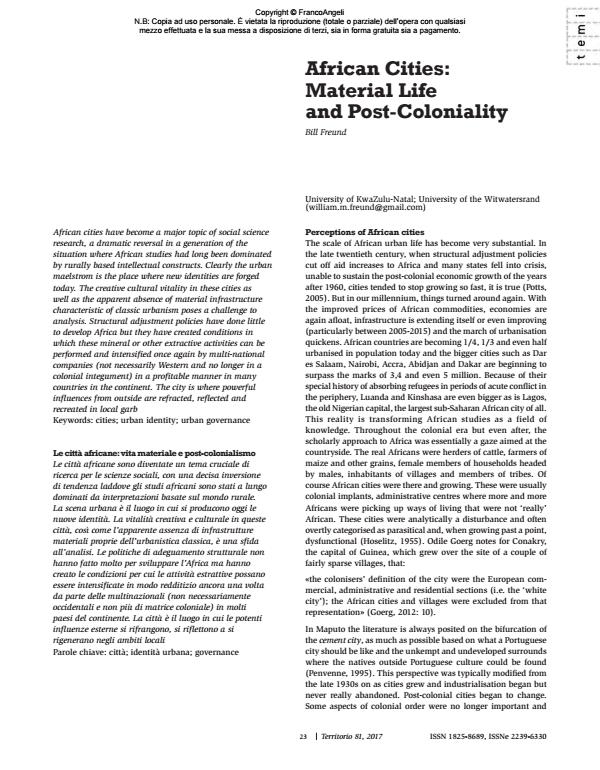African Cities: Material Life and Post-Coloniality
Titolo Rivista TERRITORIO
Autori/Curatori Bill Freund
Anno di pubblicazione 2017 Fascicolo 2017/81
Lingua Inglese Numero pagine 5 P. 23-27 Dimensione file 839 KB
DOI 10.3280/TR2017-081004
Il DOI è il codice a barre della proprietà intellettuale: per saperne di più
clicca qui
Qui sotto puoi vedere in anteprima la prima pagina di questo articolo.
Se questo articolo ti interessa, lo puoi acquistare (e scaricare in formato pdf) seguendo le facili indicazioni per acquistare il download credit. Acquista Download Credits per scaricare questo Articolo in formato PDF

FrancoAngeli è membro della Publishers International Linking Association, Inc (PILA)associazione indipendente e non profit per facilitare (attraverso i servizi tecnologici implementati da CrossRef.org) l’accesso degli studiosi ai contenuti digitali nelle pubblicazioni professionali e scientifiche
African cities have become a major topic of social science research, a dramatic reversal in a generation of the situation where African studies had long been dominated by rurally based intellectual constructs. Clearly the urban maelstrom is the place where new identities are forged today. The creative cultural vitality in these cities as well as the apparent absence of material infrastructure characteristic of classic urbanism poses a challenge to analysis. Structural adjustment policies have done little to develop Africa but they have created conditions in which these mineral or other extractive activities can be performed and intensified once again by multi-national companies (not necessarily Western and no longer in a colonial integument) in a profitable manner in many countries in the continent. The city is where powerful influences from outside are refracted, reflected and recreated in local garb
Le città africane sono diventate un tema cruciale di ricerca per le scienze sociali, con una decisa inversione di tendenza laddove gli studi africani sono stati a lungo dominati da interpretazioni basate sul mondo rurale. La scena urbana è il luogo in cui si producono oggi le nuove identità. La vitalità creativa e culturale in queste città, così come l’apparente assenza di infrastrutture materiali proprie dell’urbanistica classica, è una sfida all’analisi. Le politiche di adeguamento strutturale non hanno fatto molto per sviluppare l’Africa ma hanno creato le condizioni per cui le attività estrattive possano essere intensificate in modo redditizio ancora una volta da parte delle multinazionali (non necessariamente occidentali e non più di matrice coloniale) in molti paesi del continente. La città è il luogo in cui le potenti influenze esterne si rifrangono, si riflettono a si rigenerano negli ambiti locali
Parole chiave:Città; identità urbana; governance
Bill Freund, African Cities: Material Life and Post-Coloniality in "TERRITORIO" 81/2017, pp 23-27, DOI: 10.3280/TR2017-081004